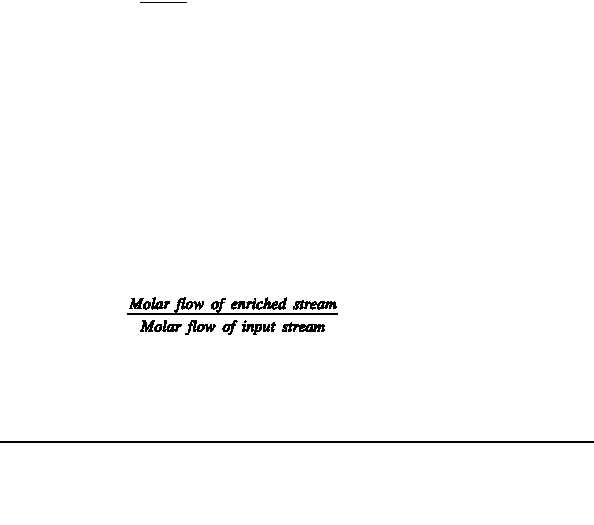?
à
BASIC SEPARATION THEORY
DOE-HDBK-1015/1-93
Appendix A
CH-01
Rev. 0
Page A-2
Separation Factor
The ability of a barrier to separate isotopes is expressed by a value called the separation
factor. It is denoted by the Greek letter ?, and is defined as the mole ratio of light
component to heavy component in the gas passing through the barrier at a given point
divided by a similar mole ratio on the high pressure surface of the barrier at the same
point. The separation factor can be expressed by the following equation.
In this equation, y and x are the mol fraction of light component on the low and high
pressure sides of the barrier respectively. It should be emphasized that ?, as shown in
Figure A-1, is a point value, and that x and y are concentrations at a given point on the
two surfaces of the barrier. In practice, point values are usually not determined. The
average ?'s of the surface of samples are calculated from experimental separation data.
As previously stated, the separation of isotopes is dependent upon the difference in the
mass of the particles. Under ideal conditions, the separation factor would be equal to
the ratio of the square roots of the molecular weights. For a mixture of U F and
235
6
U F , this value is 1.0043 and is commonly referred to as the ideal separation factor.
238
6
In actual practice, however, these ideal conditions cannot be duplicated. For example,
to approach the ideal separation factor, only a small fraction of the total gas involved
could be diffused through the barrier. For such a process to be productive, the plant size
and its power consumption would be too large to be economically feasible. Limitations
of plant size and power consumption have, necessitated a reduction in the separation
factor to a lower value. This lower value is called the actual separation factor.
Stage Separation
The ratio of the total molar rate of flow through the barrier within a converter to the
total rate of flow into the same converter is called the cut and is designated by the Greek
letter à.
In a production cascade, a cut of approximately 0.5 is the optimum value with respect
to operating efficiency and production.


